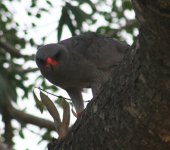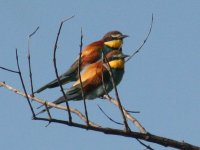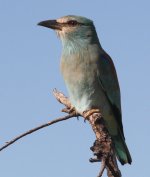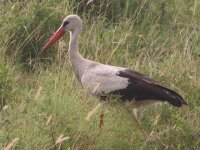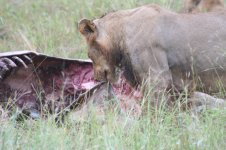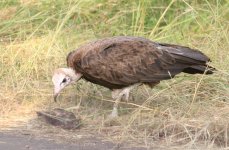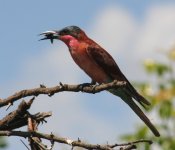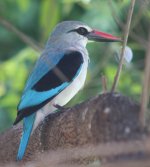Apologies for the long delay, but we've been very busy, partly as we managed to get in some bird watching here in the UK. Interestingly we saw our first swallows, having last seen them congregating in SA getting ready to leave. The journey is bad enough on a plane, what must it be like to have to make it under your own steam!
Anyway, after our big day on the Thursday we had a day off on the Friday. There is a garden centre (Kwekery) close to the Malelane gate, so we went there to buy some indigenous plants for our Marloth garden. I say we, Catherine was the one looking for the plants, I was too busy keeping an eye on the Bulbuls, Starlings and Parrots! After spending some time (and money) there we decamped to Hamiltons restaurant next door for lunch. It always pays to take binoculars and bird book with you - as we were eating on the deck I spotted a bird in the flower beds - a Groundscraper Thrush, a new spot for us. Excellent.
Next day we were back in Malelane at dawn ready for the gate to open. We had heard about Lake Panic, so our plan was to make our way up to Skukuza ans spend some time around there.
Heading up the increasingly familiar H3 tar road we saw Helmeted Guineafowl, a Tawny Eagle and a white rhino, and then came upon a cluster of cars. There were 4 male lion on a giraffe kill at the side of the road. An OSV pulled up beside us - our friend Heinrich again! He told us that the lion had actually brought the giraffe down on the road the previous afternoon - blood and guts everywhere. The park rangers had to tow the carcass off the road as it was blocking the traffic. The lion didn't seem to mind and were having breakfast. In the trees about were vultures - Lappet-faced, White-backed, Hooded. We watched for a while and then moved on to let someone in the increasingly long queue of cars behind have a look.
Moving on we came to the Matjulu river bridge. Here were White-rumped swift and two white rhino, with attendant Red-billed Oxpecker. The open plains by Afsaal had impala, warthog and a crash of 7 white rhino really close to the road. I love that collective term for rhino - a crash. It's so appropriate, just like a tower of giraffe.
We stopped at Afsaal for some coffee and breakfast. As we were eating we could hear a bird calling, familiar but we just couldn't place it, and it was being remarkably elusive in the tree-tops. The couple on the table next to us were obviously interested in birds - the man was taking numerous photos of the Scops Owl with some very nice equipment. Catherine asked the lady if she knew what was making the call. "I'll ask Hugh" she said, who promptly identified it as Orange-breasted Bush Shrike. It was no wonder he identified it so easily - we were talking to Hugh Chittenden of Roberts guide fame! Oh the reflected glory. A really pleasant and helpful couple. Our thanks to them.
We carried on up the H3. A Klipspringer was seen perched on a kopjie, and a little later one of my favourite animals - dwarf moongoose. I just love watching these delightful creatures. We had yet another Leopard Tortoise cross the road in front of us. On the bird front were Grey Lourie, telling us to go-away at every opportunity, European Rollers galore, several Bataleur eagle (or maybe just one well-travelled eagle), and at the Biyamiti crossing, Brown-headed Kingfisher, Blue and Common Waxbill and Lesser-striped Swallow.
We took another break at Skukuza. Sitting on a bench ovelooking the river eating our ice-creams we spotted Hadeda Ibis, Green Pigeon, Black-eyed Bulbul, Spotted Flycatcher, Black-collared Barbet, Chin-spot Batis and a magnificent Plum-coloured Starling. All the while we were seated there was a small bird busying itself in the bushes just the other side of the fence, but staying frustratingly well hidden. Finally just as we were about to leave it showed itself - an LBJ. Normally we move on - Martin calls them LTS - Life's Too Short, but having had this one taunt me for about 15 minutes I wasn't going to give in. Several minutes later we had it nailed - Red-faced Cisticola - a lifer!
We planned to go to the Skukuza day-vistor centre for a skottle, but when we got there it was heaving with people, so we decided to go to Nkuhlu. On our way there we took a detour to the Skukuza causeway, with good sightings of Pied Wagtail, Marabou Stork, Black-backed Puffback and Grey Heron. There were also Hippo, Baboon, Vervet Monkey, Waterbuck and Bushbuck. Nkuhlu was very quiet, so we skottled and ate in peace. Well partly in peace. There were Vervet monkeys as usual, and one of them managed to grab a bunch of bananas from another table. He then sat on a tree branch directly above me, so as I was cooking and eating I was subjected to a continuous stream of banana peel. The trials of Kruger!
From Nkuhlu we made a quick trip to Lake Panic. At the lake is a hide looking out over a beautiful lake (dam). We saw Green-backed Heron, Jacana, Wire-tailed Swallow, Purple Heron, Pied Kingfisher and Water Dikkop. Just down from the hide was a huge Golden Orb-web spider web with matching spider in the centre. Due to the distractions and diversions earlier we had only a short time available, which was a real pity as it is a beautiful place. We intend to go there again as soon as possible.
Leaving Lake Panic as late as possible we made our way back to the Malelane gate, stopping only for another look at the lions.
Another great day, with a very satisfying new tick. Our trip was coming to an end, and we only had time for one more trip into the Kruger, but that's for the next report!
Allan




